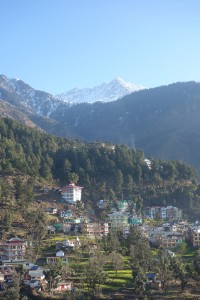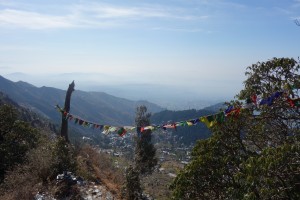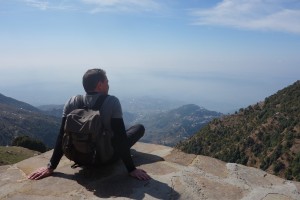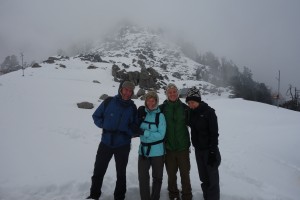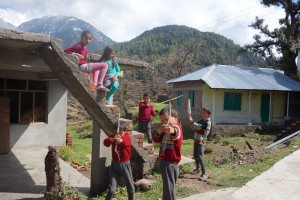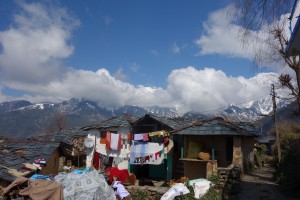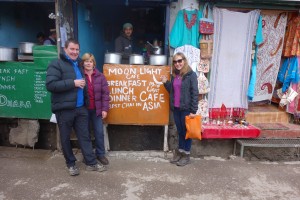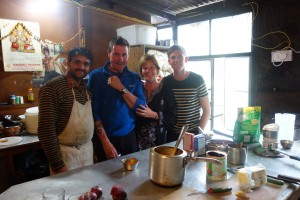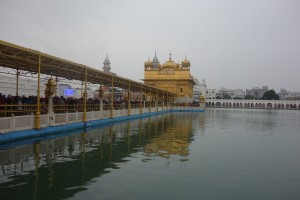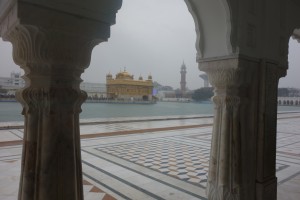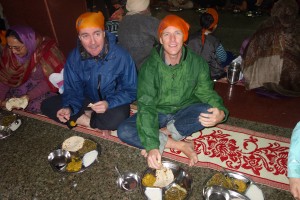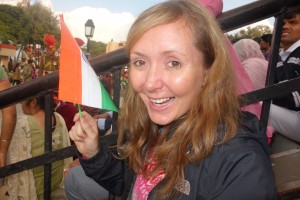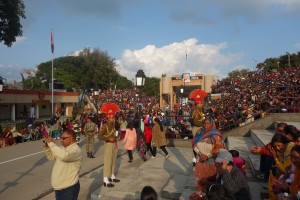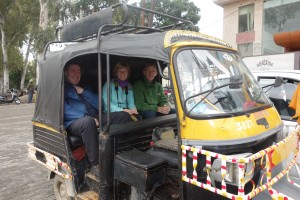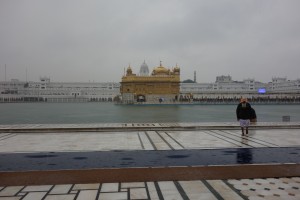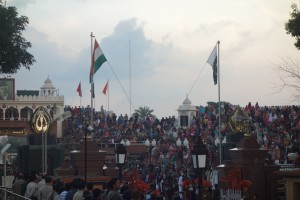We took a 2 hour train ride to Pathankot, where we caught a toy railway train. Don’t let the name fool you, ‘toy’ implies fun, and it was anything but. We boarded about 40 minutes before departure and already there were no seats left, so we ensconsed ourselves in the doorway and took turns sitting on the backpacks. The train chugged slowly up into the pretty Kangra valley but annoying fare-dodgers clung to the outside, obscuring our view. It would stop exasperatingly for 45 minutes at a time and our 2.5 hour journey stretched into 4, 5, then 6 hours. Gradually the passengers thinned and the train climbed and by sunset the Himalayas had crept into view and finally everything felt alright with the world once more.
That was until we got to Kangra, where we were supposed to catch a taxi for the final 25km to Mcleodganj. It was dark when we arrived and there was an alarming lack of taxis. Caught in a discombobulated moment, they pounced: two drunken, fly-by-night con artists who offered to take us to our destination for ‘just’ 1200 rupees (twice the going rate). In the absence of any other options we agreed. They bundled all four of us, backpacks ‘n’ all, into a beaten up Nissan Micra before both jumping in themselves and commencing to argue loudly in Hindi. We smiled fatalistically at each other. Then one of them, bemoaning the broken stereo, started to sing us his favourite song. Loudly. We started laughing hysterically; it helped to take our mind off the treacherous mountain road and the breathy smell of alcohol permeating the tiny car.
Anyway, we did finally get to Mcelod Ganj, and in one piece. It wasn’t quite the introduction to backpacking I’d hoped to give my parents, but they certainly earned their stripes! We had a few well earned beers and de-briefed.
The next morning we realised what a marvellous place we were actually at. Mcleodganj is a fantastic little tourist town built into the side of a steep slope. A minituare city of colourful town-houses strung with prayer flags and facing onto a rugged mountain-side with a snowy crest, from behind which peers a snowy white Himalayan peak. Each day we’d breakfast on the roof-top terrace against this dramatic backdrop, with eagles floating about not 6 feet above our heads.
We did a day-trek up a nearby mountain, Triund. The sun was shining; the sky was blue when we set off. We started up a rocky path shaded with tall fir trees that slowly gave way onto a winding mountain path with terrific views of the Kangra Valley. Patches of snow began to litter our path until eventually the snow became the path and we were trenching through 3 feet of snow. The peak, once we reached it, was covered in an untouched blanket of white and we huddled round a fire whilst eating a noodle lunch.
Another day we went off to explore the surrounding area. We stumbled across an incongruous British church with a shaded terraced graveyard cut into the hillside, into a village where we found slate-roofed huts, women carrying rocks on their head, goat-herds, and little boys with home-made bows and arrows. The little Indians mistook us for cowboys and one of them shot Amy. She lived though, and made them all pose for photos in retribution.
Mcleodganj is the home-in-exile of the leader of Tibetan Buddhism, the Dalai Lama. And by a fortuitous clash of calendars, he happened to be preaching there at the same time we were visiting. Everybody is welcome, and for 2 days before the event the town started filling with purple-robed monks and European hippies. We awoke at 7am and joined the throng of people making their way to the Dalai Lama Temple. Unfortunately Amy and Dad were turned away for blatantly flouting the No Cameras rule. Mum and I managed to find a cramped square foot or so of concrete at the back of the courtyard and we could, if we sort of leaned to the left and squinted a bit, just see His be-spectacled Holiness delivering his sermon in Tibetan. Now, I’ve nothing but respect for the 14th incarnation of the Dalai Lama, I think he is a truly great person and a real character to boot, but we soon came to the conclusion that we were bored stiff so we pushed our way out and went for breakfast on our roof-top terrace instead.
The Dalai Lama is not the only Tibetan exile resident at Mcleodganj, the whole town has a decidedly Tibetan feel, with Tibetan street food and handicrafts for sale, and everywhere political posters of Tibetans self-immolating (setting themselves on fire) in protest of the Chinese occupation of their country. We visited the Tibetan museum to find out why.
Free Tibet. Previously I had looked on it as a jingoistic saying, the preserve of hippies and students (a bit like Che Guevara posters), but this harrowing little exhibition changed all that. To occupy a country is one thing – the rapacious Chinese do need things to burn, and Tibet is rich in natural resources – but the systematic eradication of 2000 years of Tibetan culture is a little hard to swallow. Ancient ruins destroyed, relics defecated on, people tortured and killed, religious leaders kidnapped; all because the idea of a Tibetan identity is an effrontery to the mono-ethnic communist state. The peaceful Tibetans are being consigned to the history books and are fighting back in the form of non-violent protests and self-immolation. We all left with a disturbing sense of the wrong-doing on the part of the Chinese, and sadly the futility of peaceful protest on the part of the Tibetans.
Anyway, rant over. We have had a great 2 weeks with Mad and Steve but have now gone our separate ways. Gladly, they loved India as we do: they took a cab back to Amritsar, already plotting their next visit. For us, our visit is not yet over; we took the bus to Shimla.

